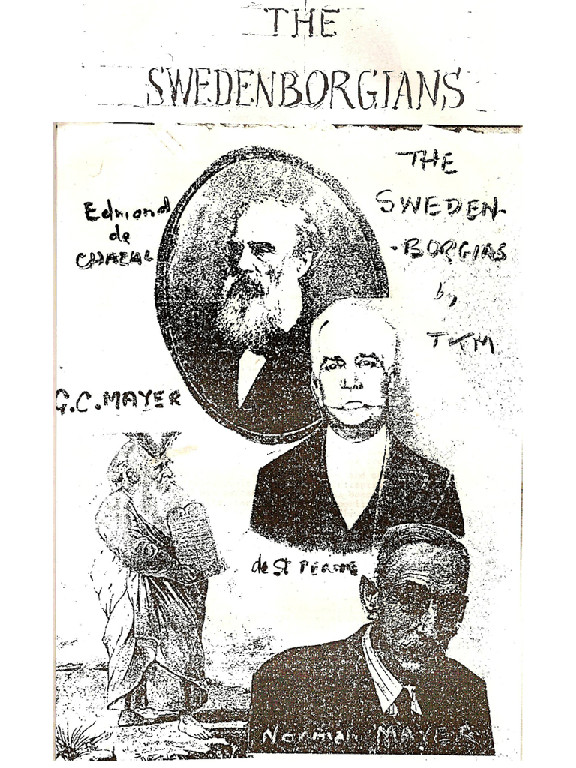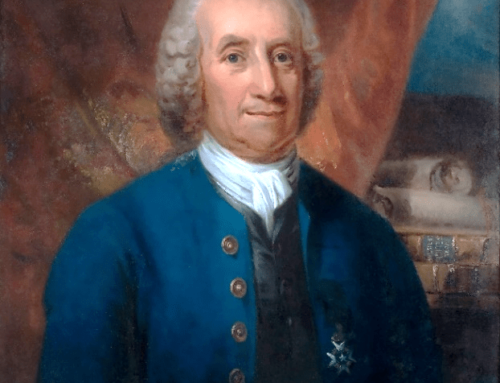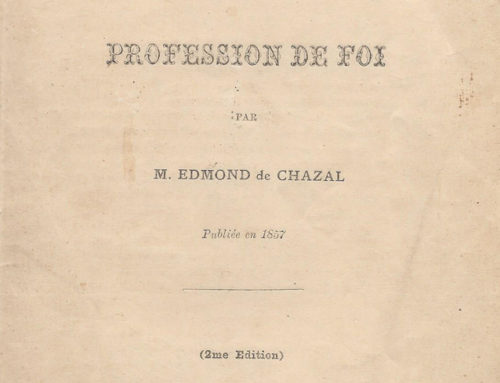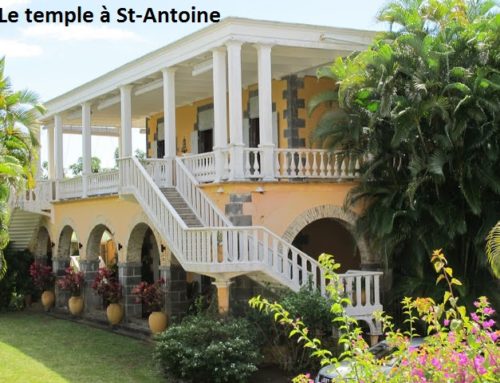Tomi Mayer (1917) < Ralph Mayer (1886) < Berthe de Chazal (1856) < Edmond de Chazal (1809) < Toussaint de Chazal (1770) < Régis de Chazal (1735) < Noble Aimé de Chazal (1706) < Jean-Baptiste ( 16..) < Jean II Chazal (16..) < Jean I (16..)
Swedenborg
Dear Josephine, I promised I would tell you about the Swedenborgians of Mauritius, but first I thought of acquainting you with the philosopher who inspired this religion. I found a book about him on my shelves and to my surprise discovered it belonged to my brother Ralf. I had no idea he was interested enough to keep such a book. I read the book and took some notes with a view to writing an essay but did not feel equal to the task. That was many months ago. I put it all to rest for a while.
Because of our conversation I thought of taking up my task anew. This time around I decided I would consult the Encyclopaedia Britannica as an easy way out. The following is abstracted from that work interspersed with some of the notes I took from the book by Trobridge.
EMMANUEL SWEDENBORG was born on 29th January 1688. He was the son of a bishop who claimed that angels visited him. He graduated in 1709 at the University of Uppsala. During his studies he became fascinated with mathematics and natural sciences. When he graduated he travelled to England in the hope of meeting Issac Newton but failed to do so, however he met Flamsteed and Halley and other leading scientists, members of The Royal Society. He remained ten years in England. Subsequently travelled to Holland and Paris and returned to Sweden having gained an initiation into modern science that surpassed that of his contemporaries.
He published a treaties on a mode of finding longitude at sea by means of the moon, the most pressing problem of his day.
Because he founded a scientific paper and contributed numerous articles to it he gained the attention of The King who appointed him assessor of the Royal Board of Mines. He spent the five years in this post publishing several reports and treaties on various scientific and philosophical problems.
Influenced by Descartes, for the next few years, looked for a language (symbolic or scientific) in which relations between the infinite and finite creation could be expressed with mathematical exactitude.
Swedenborg made a thorough study of the human anatomy, with special attention to blood and brain. In fact his object was to find the site of the soul. His energy and his erudition were overwhelming. He was not successful in his attempt at a universal language based on the model by Descartes and Leibniz so at last made up his mind to present a substitute: the famous doctrine of correspondence, that is how to transform a composition from its natural sphere into the correspondence in the spiritual sphere, a prominent feature of his later theological works.
His work on the atom has been described as essentially identical with those of our most advanced scientific theories of today. In anatomy and philosophy, as in cosmology and physics, Swedenborg reached out towards conclusions and concepts that later discoveries confirmed.
On 7th April 1744 he had his first vision of Christ. A definite call to abandon worldly learning occurred a year later. For the remainder of his long career Swedenborg devoted his enormous energy in interpreting the Bible and writing spiritual and philosophical books. He never acted as a preacher but rather relied totally on the effect of his huge Latin output.
Before his sudden change of direction from scientist to theology Swedenborg had shown no inclination toward the latter subject. He said that, unknown to himself; the Lord had been preparing him from his childhood to be the means whereby a new revelation of Divine Truth, still based on the scriptures, should be made known. It was also an integral part of his theology that this new revelation was in fact THE SECOND ADVENT OF JESUS CHRIST.
He asserted that the teaching now given was not his own but directly from Lord Jesus Christ who appeared to him and commanded him to write what should be taught and that his spiritual senses were opened so that he could be in the Spiritual World as one of its inhabitants at the same time as he was in the material world. He is not a mystic, there is nothing ecstatic or rhapsodic; his manner is plain, dry, methodical, matter of fact and rational.
Swedenborg had a religious crisis when he kept a diary of his dreams and their interpretation. He published his diary and was not ashamed of some of his dreams which were of a grossly sexual nature. His feeling of guilt was concentrated on his intellectual pride and his burning ambition to be recognised as a man of science.
Emmanuel Swedenborg died in London on 29th march 1772
A few titles of Swedenborg’s writings: HEAVEN AND HELL; THE DIVINE LOVE AND WISDOM; THE DIVINE PROVIDENCE; THE TRUE CHRISTIAN RELIGION.
* * * * * * * * * * * *
When I was seven we lived for a few months opposite what its congregation called their “Temple”
As a child I was fed a variety of anecdotes about how the religion was established in Mauritius, none of which was correct. For instance my Aunt Yvonne de Chazal, whose father was converted at the age of twenty to this new faith, writes this for her children:
…….[Edmond de Chazal, my grandfather] came to France? (an indecipherable word) when he was 40, heard of Swedenborg, had seen a book of Swedenborg on board ship and had read it. He helped to have all the books of Swedenborg translated into French and took all of them to Mauritius and he gave them to his wife and children demanding that they renounce the Catholic religion. It was a great scandal and nearly broke the heart of grandmother who was a devoted Catholic. She was sweet, shy and never dared to stand up to her husband. He preached and converted brothers, sisters and other people fighting to establish the New Church in Mauritius. But those who knew him adored and admired him a lot. He was generous, kind, sincere and loveable though having a terrible temper and will of iron—my mother adored him. He was so kind and generous to her….
Presently I will show how inaccurate most of this statement is.
Germaine Rouillard gave me the following verifiable details about the first Swedenborg Society.
Robert Hindmarsh, son of a Methodist pastor, was a typographer and publisher in London. He was printing the latin works of Swedenborg which he was also reading: such titles as heaven and Hell, life After Death and so on. He was so impressed that he spoke to his father about these books. Together they studied and discussed the work of the philosopher. They finaly put a notice in the Papers asking all those who had read and were interested in Swedenborg to meet them at a certain time and date at an address somewhere in London. After this meeting those present decided to form a religious group which they called “The New Jerusalem”. In order to decide who would christen the new recruits: father or son, they resorted to ‘the short straw’ and the honour fell to the son.
That was the fist Swedenborg Society-cum-church. Others were established in America, Canada and Australia. The latter is important as far as Mauritius is concerned.
“In 1846 a teacher of languages, George Herbert Poole, left Adelaide for Mauritius. A society of the New Church had been formed in Australia on the initiative of Jacob Pitman, and Mr Poole was one of the four persons who assembled at the latter’s house to follow the New Church teachings……He (Poole) only stayed three years in Mauritius but during that time did all he could to spread The heavenly Doctrines. At first only three Englishmen accepted them, and soon after these gentlemen left for Calcutta. Mr Poole then made the acquaintance of many Mauritian families and of the two brothers Le Sage in particular.
Among Mr Pool’s acquaintances was a poor painter named Louis Emile Michel….Mr Poole returned to Australia in 1850and left Mr Michel at the head of the movement. The latter at once contacted Mr Le Boys des Guays, founder of the New Church in France and translator of Swedenborg’s works into French and asked him for books which he then sold to friends of The New Church in Mauritius, and gave away free to those who could not afford them.
But being a poor and not enjoying a great influence, his efforts proved insufficient to implant the New Church on the island…..In order that the movement should spread, an influential, intelligent, strong-willed man was needed.
Such a man was soon to be found in the person of Edmond de Chazal, a rich sugar-cane planter of Rivière du Rampart.
In 1854 Mr Michel sent to him a large number of Swedenborg’s works and also at the same time to the Le Sage brothers, who, —although they had met Mr Poole—- were not yet fully convinced of the truths of the New Church. These three gentlemen began to study these books carefully and diligently, and it was not long before they accepted unreservedly all the truths they contained. Mr de Chazal began a regular exchange of correspondence with Mr Le Boys des Guays, asking him for advice and sending him large sums of money to be used for the printing and publishing of French translations of Swedenborg’s works. By his intelligent teaching he soon brought his large family to the light of the New Church, and in 1858, he started a ‘Family Worship’ group at his home, in which many relations and friends took part.
…..An important occurrence for the future of the society was the journey to Europe in 1863 by Mr Evenor de Chazal, eldest son of Edmond (and father of Aunt Yvonne). He visited the different societies of the New Church in England, jersey, France, Switzerland and Germany. …..In 1863 the Society consisted of seventy-five members, including the children baptized in the New Church. [extracts from an article by Rev Cornelius Becherel in the New Church Magazine Vol197]
N.B. My grandmother Berthe de Chazal, daughter of Edmond, was born in 1856 and christened a catholic at their parish church of St. Philomena, Poudre d’Or. She was the twelfth child of a family of sixteen children.
There is a spiritual gene in the de Chazal family that throws up priests in every generation as well as spiritual people such as Edmond himself and my brother Septimus for example. Edmond must have possessed that gene as he was a thinker and searcher of truth. His catholic religion could not have pleased him especially as manifested in Mauritius of his day. In 1841 the newly appointed bishop Collier wrote the following letter soon after he took up his appointment:
I could not have imagined that a Christian country could fall into such moral degradation. The Europeans often ignore their religion, the people of this country are not unlike the inhabitants of china or Kamchatka. How could it be otherwise? No one has given them the slightest consideration. What astounds me even more than their ignorance, is, in spite of suffering such neglect, they still desire to be instructed. …..On arrival I found here eight Priests. I have already sent back three and there are three more I cannot throw out.” [Downside Abbey Archives]
The poor Bishop begs a friend in London to send him three suitable ecclesiastics but only one is sent who disembarked in January 1843 with a woman listed as his wife in the list of passengers.
Laval, a doctor turned priest and later canonised, arrived in Mauritius in 1841 at the same time as Bishop Collier. His assessment of the Catholic Church is even worse than that of the Bishop. He writes:
“I have nothing good to report about the clergy. The priests here have come to make money and to amuse themselves. Our good Bishop bemoans the present situation every day. Sadly he is not master of his diocese and is unable to be rid of these bad priests and it is quite unbelievable all the scandals which they have engendered in this poor island. And Montseigneur has told me more than once that he is astounded that even a little faith remains in his Curacy…”
Laval was attempting to help the freed slaves against great odds. The historian Toussaint writes:
With wondrous zeal he devoted himself in the moral education of the freed slaves. Indeed, he ha there an extremely arduous task but thanks to his unflagging dedication, to his patience. And to his kindness he obtained really surprising results.
The social reach of his labour was immense and one could say without exaggeration that due to him alone, this missionary did more to maintain public order and calm in the capital, seat of his ministry, than the whole of the police force.
Yet Laval was accused of fomenting revolution among other evils. In another letter he has this to report:
“All the Whites who live in Mauritius are people who are only concerned with money and for whom religion is nothing at all. Consequently they lead astray the poor folk (the freed slaves) and mock them instead of encouraging them…..They say I waste their servant’s time, and tell them not to harken to the priests who are monsters; and these people allow themselves to be distracted. …. The masters make fun of their servants when they want to attend mass on Sunday, and come Friday it is nothing but a series of mockery about Sunday observance.
“There is an incredible corruption and dissoluteness of morals…..All the unfortunate black women are debauched by their employers and the young white men. …It is the custom among the latter to have a mistress and to change them often. Once married they keep one or two concubines, and their legitimate wives do not even dream of complaining.”
This is the chief source of worry of the ruling classes and consequently their persecution of Laval.
The white population resent him—he is the GREAT BLACK BEAST; he has, they complain, corralled all the negresses and not a woman is to be found: Laval has taken them all for himself….The young men do not stop at insults and calumny, they pursue their impudence by entering the church in search of negresses, pinching them and talking at the top of their voice.
It is not known whether Edmond de Chazal met Laval—probably not as he might not have embraced Swedenborg’s work so readily. It is interesting to note that Hilaire Belloc, the very catholic writer, in his biography of William Blake, an early Swedenborgian describes the Swedish philosopher as a genius who in all innocence re-invented the catholic doctrine. This in a way makes the two faiths brothers, and the rivalry of brothers is legendary. My father always said that the sole purpose of the New Church, in his day, was to be anti-catholic. And visa-versa. The catholic church attaked the new religion and in particular Edmond de Chazal himself most vigorously.
In his defence Edmond wrote a tract entitled “I’m and apostate.” [A person who renounces a former belief].
I am an apostate. I have deserted the religion of my fathers. I have trampled on my nationality.
Such is the curse hurled at me by the Roman church because I have shaken off its yoke. I am an apostate for not wishing to accept the substitution of human power for Divine power.
I am an apostate finally for having scorned the curse and excommunication of the Church which wishes to recognise no other authority but its own, and whose blind faith is based only on constraint and intolerance. Freedom of conscience alarms them—they must have bondage from birth and they exercise this authority through which they hope to keep us under their domination for life by exacting an oath from the father at the cradle, most often by intimidation and constraint—what am I saying?—even before the child is conceived.
This is a very long tract. It goes on to say “according to these principles, the most compelling duty of man would be to remain stationary indefinitely in the condition in which he had been born. So if you first Christians are apostates….” That the Catholic Church has a history of crime: the massacre of St Bartholemew as a specific example. He explains the reason for the French Revolution. “Who would still dare to say that the flag of France was the flag of Roman Catholicism; who would dare to say that he who rejects the Roman Doctrine renounces by this deed alone, his French Nationality?” And he ends:
Then how would it be possible in a country such as ours (Mauritius) where so many religions come into collision; how would it be possible for the Roman Catholic priest to preach universal charity; how can he advise to call brothers those very people when the principles of his Faith or Doctrine condemns to Eternal punishment Huguenots and heretics?
Truly reason confounds itself in trying to understand the spirit of Rome where it is where it is so simple and pleasant to understand The Lord when we read his Word and he tells us: ‘This is my commandment: that you love one another as I loved you.’ (June 1859)
Edmond mentions ‘excommunication of the Church’. I had a most vivid description by Claire Jones, great-grand-daughter of Edmond, how the latter was excommunicated. She told me that all the Catholics filled the cathedral called there to witness the ceremony of excommunication. The priest named, then cursed every bit of Edmond’s anatomy, from head to feet. Catholics were henceforth forbidden to fraternise with new Church goers.
I was sceptical enough to write to the catholic archbishop of Mauritius—we were contemporise and attended the same school. I had the following reply:
I have had extensive investigation on the matter and am forwarding you the results.
Dr Arthur de Chazal (he reverted back to being R.C.) and father Henri Souchon (his mother left the new Church for the R.C. Church) grandson and great-grandson, respectively of Pierre-Edmond, nephew of Joseph Antoine Edmond de Chazal, state that no clue of any excommunication promulgated by the R.C. Church authorities had been handed down in their local family circles.
At the Bishop’s house, no file has been preserved in connection with the above matter.
On January 23rd 1874, father E. Rebreyand a Jesuit priest, incumbent of Poudre d’Or, near which place lived J.A.E. de Chazal, wrote to him a letter, later published by the latter, whereby the missionary invites him to resume his seat in one of the pews of St. Philomena Church, Poudre d’Or. Such plain invitation hardly makes sense had J. Antoine Edmond de Chazal’s separation from the Church been sanctioned by a sentence of excommunication.
On January 25th, the addressee replied to the Jesuit missionary thanking him for his friendly letter, yet declining the invitation to attend once again divine service at St. Philomena Church as “for several years now” he added, “my faithis different from the one professed by the ministers of your congregation”. Had an excommunication been inflicted him, his omitting to even slightly alluding to it would look most strange…..
….So even if Joseph Antoine Edmond de Chazal had actually been excommunicated, I an afraid I have no documentary evidence or reference to support that fact, just as I have none either pointing to his not having been excommunicated.
Signed Jean Margeot
Edmond de Chazal died in 1879. His funeral was held in Port Louis. Many of his religious enemies were present, though the Bishop had prohibited his congregation to assist the funeral.
My grandfather George Clifford Mayer not only embraced the doctrine of the New Church but was a prominent member. For twenty years he was vice president of the New church. His son Norman took up the ministry. My father was most sceptical. Out of curiosity I asked my first cousin George Emmanuel, son of the Rev. Norman Mayer, about his religious upbringing. He said he and his brothers were thoroughly indoctrinated but he himself concluded that Swedenborg’s Writings were like fairy tales, on a par with Lewis Carol’s Alice books. I attended his funeral in a catholic church arranged by his catholic wife. He once affirmed to me that he was atheist.
Many of the early enthusiastic converts to the New Church later went back to the church of their fathers, namely the Catholic Church but most of the Chazals’ kept the ‘faith’ and in my youth the temple we lived opposite was called the Chazal church. There is less animosity between the two faiths but a few malicious allegations still linger. I will give one example. When my Uncle Clifford’s only son died tragically at the age of fifteen, one of my colleagues at work asked me whether it was a fact that my uncle, far from mourning gave a celebratory banquet in honour of his son’s entry into Heaven.
In my earlier essay I wrote: Swedenborg , as a scholar studied the philosophy of Plato and like others was greatly influenced by him. The doctrine of correspondence is not unlike what Plato wrote in ‘Timaeus’: The visible mutable world had a beginning; it is the work of God, who had its FORMS before him as an eternal model in terms of which he modelled the world as an imitation. The early Christian theologians borrowed a great deal from Plato as well as the Jewish scriptures. The Catholics claim that Plato was a pre-christian Christian. Swedenborg was not a preacher and he certainly was not anti-catholic. His main contribution was the doctrine (I think he called it science) of Correspondence, a philosophic concept that can be traced directly back to Plato.
I hope dear Josephine; I have filled the gap you were suddenly aware of by meeting some Swedenborgians at George and Pauline’s Golden Wedding anniversary celebrations.
With Love from TOMI.
P.S. Pierre Edmond, nephew and (later) son-in-law of Edmond de Chazal of St. Antoine wrote in his diary at the end of March 1857:
“A fierce debate was taking place among the men at table on the religion of “Swedenborg” of the New Jerusalem. The abbot MacDonald was amazed”
Pierre Edmond de Chazal kept a diary for his first cousin George Clifford Mayer who was studying law in London. The above was part of a description of the dinner party celebrating their Aunt Malcy’s fifty-third birthday. The Abbot was evidently one of her friends. By the date it would seem that it must have been Malcy’s brother Edmond de Chazal who introduced the subject as he was probably in the throes of studying the books sent to him by Emile Michel.[1] Church in Rémono Street, Curepipe. See Christopher de Chazal’s diary of his trip to Mauritius in 2009





